GMC SAVANA 2007 Owner's Manual
Manufacturer: GMC, Model Year: 2007, Model line: SAVANA, Model: GMC SAVANA 2007Pages: 452, PDF Size: 2.68 MB
Page 261 of 452
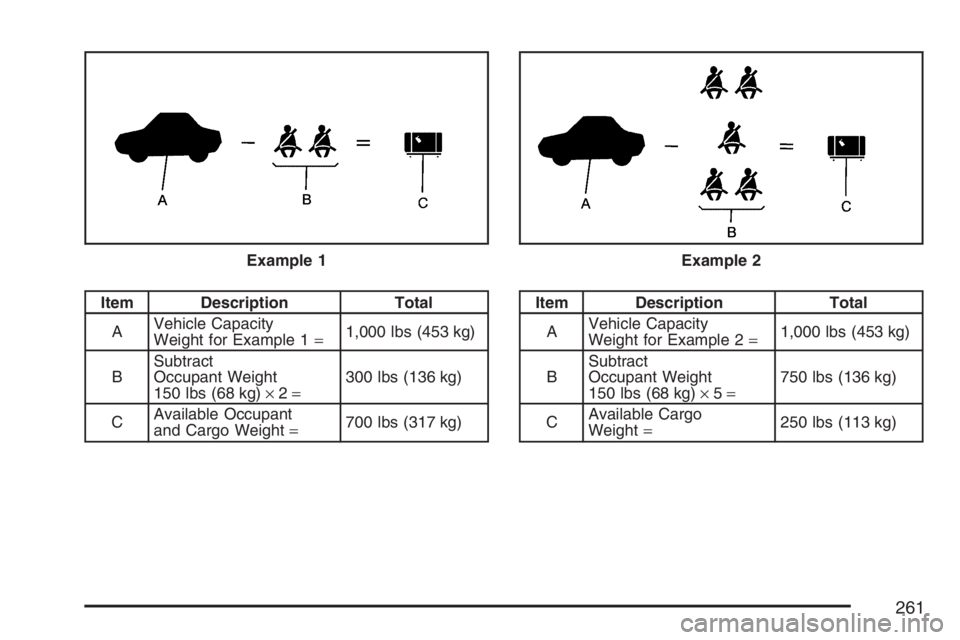
Item Description Total
AVehicle Capacity
Weight for Example 1=1,000 lbs (453 kg)
BSubtract
Occupant Weight
150 lbs (68 kg)×2=300 lbs (136 kg)
CAvailable Occupant
and Cargo Weight=700 lbs (317 kg)Item Description Total
AVehicle Capacity
Weight for Example 2=1,000 lbs (453 kg)
BSubtract
Occupant Weight
150 lbs (68 kg)×5=750 lbs (136 kg)
CAvailable Cargo
Weight=250 lbs (113 kg) Example 1
Example 2
261
Page 262 of 452
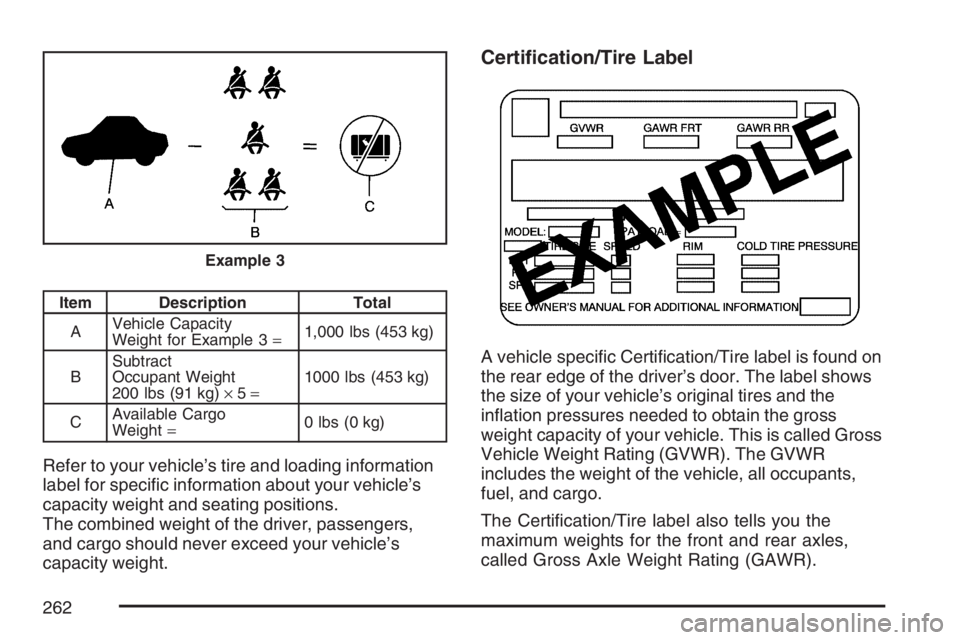
Item Description Total
AVehicle Capacity
Weight for Example 3=1,000 lbs (453 kg)
BSubtract
Occupant Weight
200 lbs (91 kg)×5=1000 lbs (453 kg)
CAvailable Cargo
Weight=0 lbs (0 kg)
Refer to your vehicle’s tire and loading information
label for specific information about your vehicle’s
capacity weight and seating positions.
The combined weight of the driver, passengers,
and cargo should never exceed your vehicle’s
capacity weight.
Certi�cation/Tire Label
A vehicle specific Certification/Tire label is found on
the rear edge of the driver’s door. The label shows
the size of your vehicle’s original tires and the
inflation pressures needed to obtain the gross
weight capacity of your vehicle. This is called Gross
Vehicle Weight Rating (GVWR). The GVWR
includes the weight of the vehicle, all occupants,
fuel, and cargo.
The Certification/Tire label also tells you the
maximum weights for the front and rear axles,
called Gross Axle Weight Rating (GAWR).
Example 3
262
Page 263 of 452
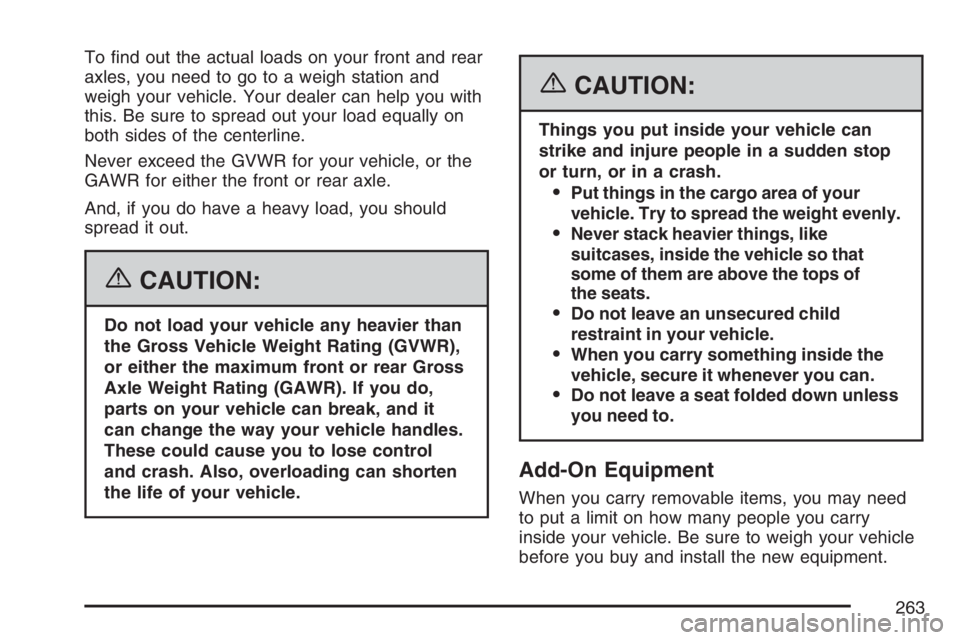
To find out the actual loads on your front and rear
axles, you need to go to a weigh station and
weigh your vehicle. Your dealer can help you with
this. Be sure to spread out your load equally on
both sides of the centerline.
Never exceed the GVWR for your vehicle, or the
GAWR for either the front or rear axle.
And, if you do have a heavy load, you should
spread it out.
{CAUTION:
Do not load your vehicle any heavier than
the Gross Vehicle Weight Rating (GVWR),
or either the maximum front or rear Gross
Axle Weight Rating (GAWR). If you do,
parts on your vehicle can break, and it
can change the way your vehicle handles.
These could cause you to lose control
and crash. Also, overloading can shorten
the life of your vehicle.
{CAUTION:
Things you put inside your vehicle can
strike and injure people in a sudden stop
or turn, or in a crash.
Put things in the cargo area of your
vehicle. Try to spread the weight evenly.
Never stack heavier things, like
suitcases, inside the vehicle so that
some of them are above the tops of
the seats.
Do not leave an unsecured child
restraint in your vehicle.
When you carry something inside the
vehicle, secure it whenever you can.
Do not leave a seat folded down unless
you need to.
Add-On Equipment
When you carry removable items, you may need
to put a limit on how many people you carry
inside your vehicle. Be sure to weigh your vehicle
before you buy and install the new equipment.
263
Page 264 of 452
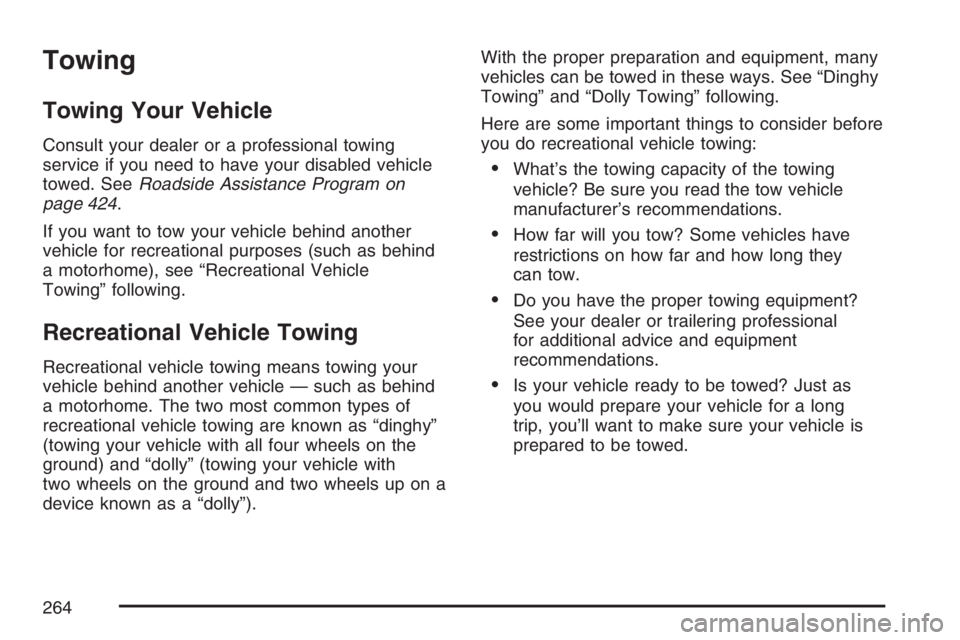
Towing
Towing Your Vehicle
Consult your dealer or a professional towing
service if you need to have your disabled vehicle
towed. SeeRoadside Assistance Program on
page 424.
If you want to tow your vehicle behind another
vehicle for recreational purposes (such as behind
a motorhome), see “Recreational Vehicle
Towing” following.
Recreational Vehicle Towing
Recreational vehicle towing means towing your
vehicle behind another vehicle — such as behind
a motorhome. The two most common types of
recreational vehicle towing are known as “dinghy”
(towing your vehicle with all four wheels on the
ground) and “dolly” (towing your vehicle with
two wheels on the ground and two wheels up on a
device known as a “dolly”).With the proper preparation and equipment, many
vehicles can be towed in these ways. See “Dinghy
Towing” and “Dolly Towing” following.
Here are some important things to consider before
you do recreational vehicle towing:
•What’s the towing capacity of the towing
vehicle? Be sure you read the tow vehicle
manufacturer’s recommendations.
•How far will you tow? Some vehicles have
restrictions on how far and how long they
can tow.
•Do you have the proper towing equipment?
See your dealer or trailering professional
for additional advice and equipment
recommendations.
•Is your vehicle ready to be towed? Just as
you would prepare your vehicle for a long
trip, you’ll want to make sure your vehicle is
prepared to be towed.
264
Page 265 of 452
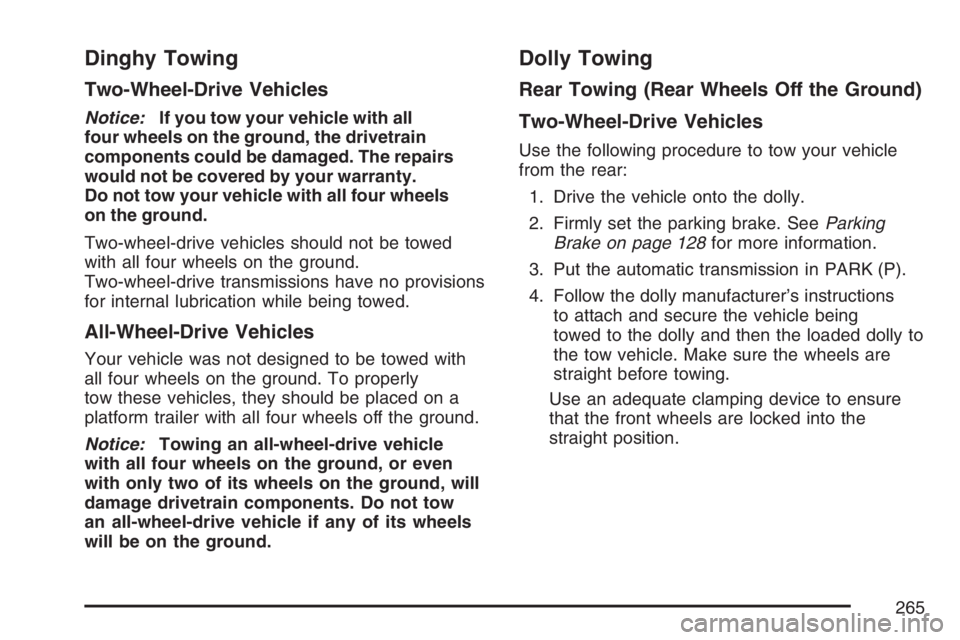
Dinghy Towing
Two-Wheel-Drive Vehicles
Notice:If you tow your vehicle with all
four wheels on the ground, the drivetrain
components could be damaged. The repairs
would not be covered by your warranty.
Do not tow your vehicle with all four wheels
on the ground.
Two-wheel-drive vehicles should not be towed
with all four wheels on the ground.
Two-wheel-drive transmissions have no provisions
for internal lubrication while being towed.
All-Wheel-Drive Vehicles
Your vehicle was not designed to be towed with
all four wheels on the ground. To properly
tow these vehicles, they should be placed on a
platform trailer with all four wheels off the ground.
Notice:Towing an all-wheel-drive vehicle
with all four wheels on the ground, or even
with only two of its wheels on the ground, will
damage drivetrain components. Do not tow
an all-wheel-drive vehicle if any of its wheels
will be on the ground.
Dolly Towing
Rear Towing (Rear Wheels Off the Ground)
Two-Wheel-Drive Vehicles
Use the following procedure to tow your vehicle
from the rear:
1. Drive the vehicle onto the dolly.
2. Firmly set the parking brake. SeeParking
Brake on page 128for more information.
3. Put the automatic transmission in PARK (P).
4. Follow the dolly manufacturer’s instructions
to attach and secure the vehicle being
towed to the dolly and then the loaded dolly to
the tow vehicle. Make sure the wheels are
straight before towing.
Use an adequate clamping device to ensure
that the front wheels are locked into the
straight position.
265
Page 266 of 452
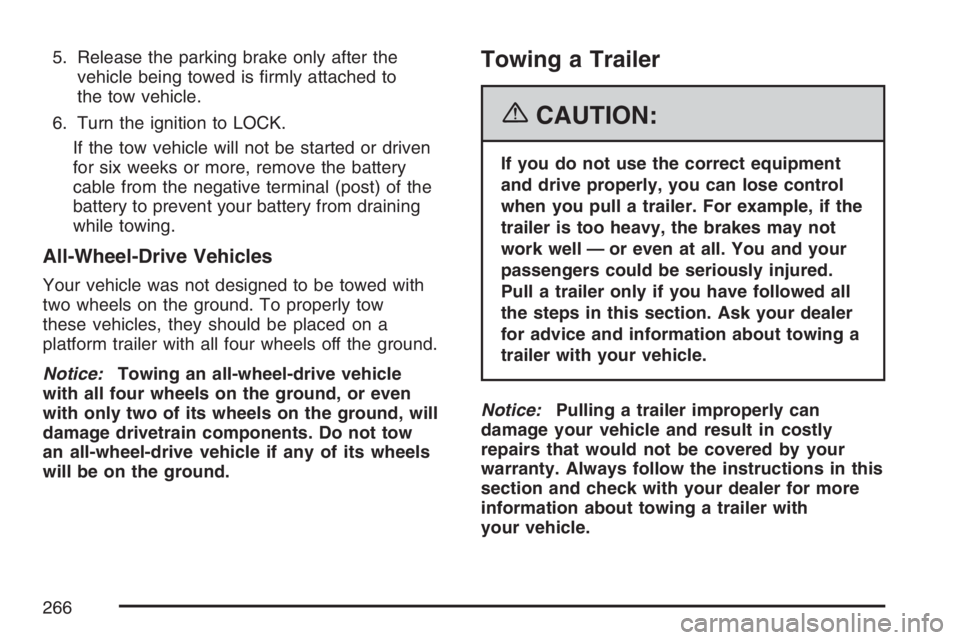
5. Release the parking brake only after the
vehicle being towed is firmly attached to
the tow vehicle.
6. Turn the ignition to LOCK.
If the tow vehicle will not be started or driven
for six weeks or more, remove the battery
cable from the negative terminal (post) of the
battery to prevent your battery from draining
while towing.
All-Wheel-Drive Vehicles
Your vehicle was not designed to be towed with
two wheels on the ground. To properly tow
these vehicles, they should be placed on a
platform trailer with all four wheels off the ground.
Notice:Towing an all-wheel-drive vehicle
with all four wheels on the ground, or even
with only two of its wheels on the ground, will
damage drivetrain components. Do not tow
an all-wheel-drive vehicle if any of its wheels
will be on the ground.
Towing a Trailer
{CAUTION:
If you do not use the correct equipment
and drive properly, you can lose control
when you pull a trailer. For example, if the
trailer is too heavy, the brakes may not
work well — or even at all. You and your
passengers could be seriously injured.
Pull a trailer only if you have followed all
the steps in this section. Ask your dealer
for advice and information about towing a
trailer with your vehicle.
Notice:Pulling a trailer improperly can
damage your vehicle and result in costly
repairs that would not be covered by your
warranty. Always follow the instructions in this
section and check with your dealer for more
information about towing a trailer with
your vehicle.
266
Page 267 of 452
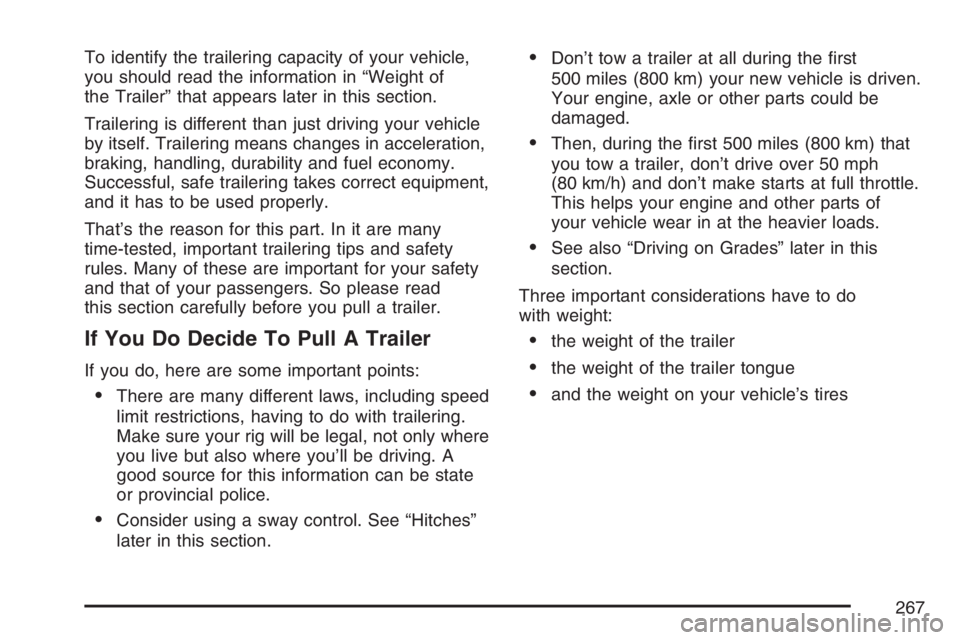
To identify the trailering capacity of your vehicle,
you should read the information in “Weight of
the Trailer” that appears later in this section.
Trailering is different than just driving your vehicle
by itself. Trailering means changes in acceleration,
braking, handling, durability and fuel economy.
Successful, safe trailering takes correct equipment,
and it has to be used properly.
That’s the reason for this part. In it are many
time-tested, important trailering tips and safety
rules. Many of these are important for your safety
and that of your passengers. So please read
this section carefully before you pull a trailer.
If You Do Decide To Pull A Trailer
If you do, here are some important points:
•There are many different laws, including speed
limit restrictions, having to do with trailering.
Make sure your rig will be legal, not only where
you live but also where you’ll be driving. A
good source for this information can be state
or provincial police.
•Consider using a sway control. See “Hitches”
later in this section.
•Don’t tow a trailer at all during the first
500 miles (800 km) your new vehicle is driven.
Your engine, axle or other parts could be
damaged.
•Then, during the first 500 miles (800 km) that
you tow a trailer, don’t drive over 50 mph
(80 km/h) and don’t make starts at full throttle.
This helps your engine and other parts of
your vehicle wear in at the heavier loads.
•See also “Driving on Grades” later in this
section.
Three important considerations have to do
with weight:
•the weight of the trailer
•the weight of the trailer tongue
•and the weight on your vehicle’s tires
267
Page 268 of 452
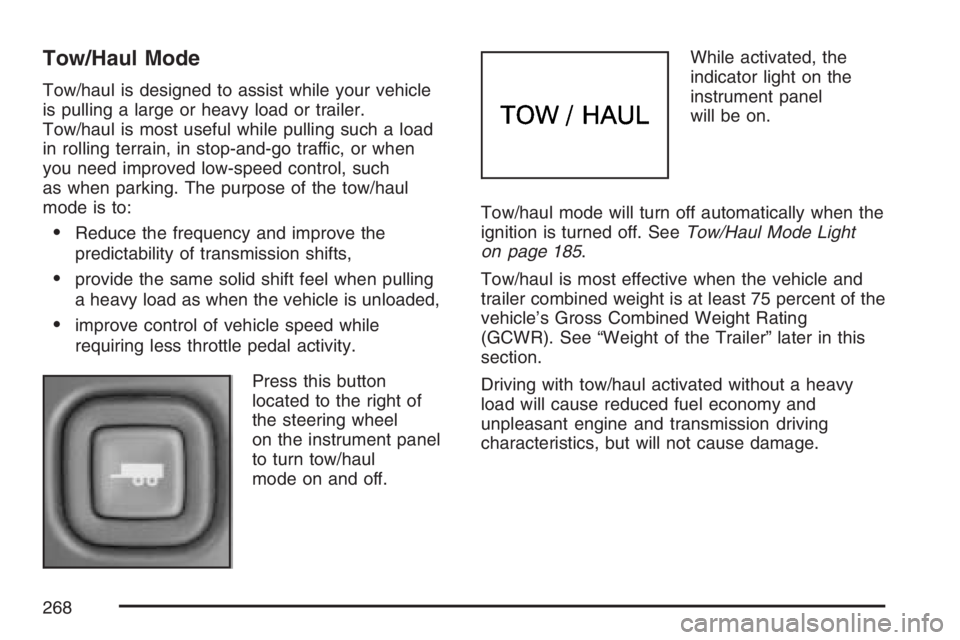
Tow/Haul Mode
Tow/haul is designed to assist while your vehicle
is pulling a large or heavy load or trailer.
Tow/haul is most useful while pulling such a load
in rolling terrain, in stop-and-go traffic, or when
you need improved low-speed control, such
as when parking. The purpose of the tow/haul
mode is to:
•Reduce the frequency and improve the
predictability of transmission shifts,
•provide the same solid shift feel when pulling
a heavy load as when the vehicle is unloaded,
•improve control of vehicle speed while
requiring less throttle pedal activity.
Press this button
located to the right of
the steering wheel
on the instrument panel
to turn tow/haul
mode on and off.While activated, the
indicator light on the
instrument panel
will be on.
Tow/haul mode will turn off automatically when the
ignition is turned off. SeeTow/Haul Mode Light
on page 185.
Tow/haul is most effective when the vehicle and
trailer combined weight is at least 75 percent of the
vehicle’s Gross Combined Weight Rating
(GCWR). See “Weight of the Trailer” later in this
section.
Driving with tow/haul activated without a heavy
load will cause reduced fuel economy and
unpleasant engine and transmission driving
characteristics, but will not cause damage.
268
Page 269 of 452
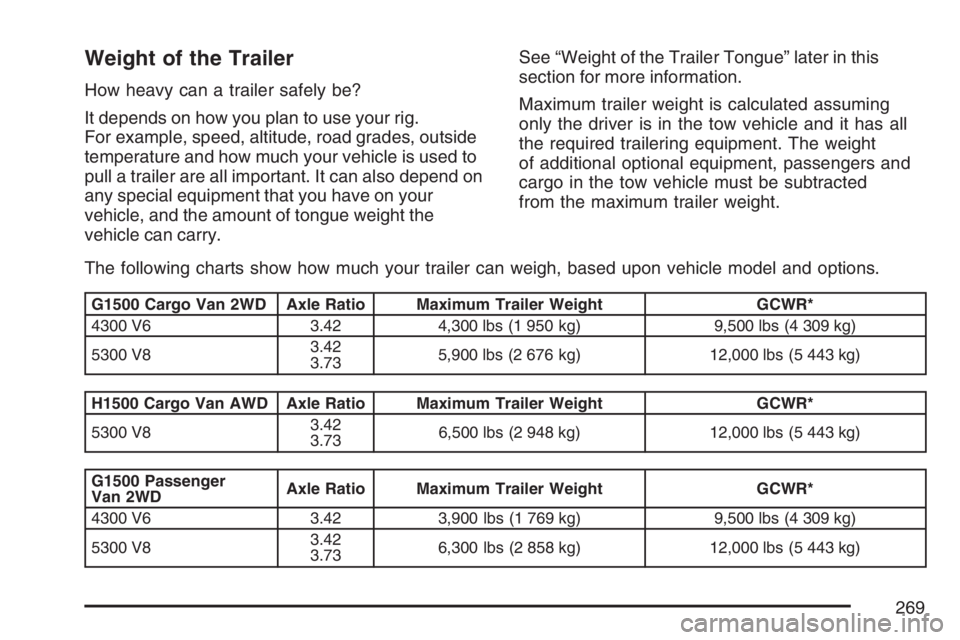
Weight of the Trailer
How heavy can a trailer safely be?
It depends on how you plan to use your rig.
For example, speed, altitude, road grades, outside
temperature and how much your vehicle is used to
pull a trailer are all important. It can also depend on
any special equipment that you have on your
vehicle, and the amount of tongue weight the
vehicle can carry.See “Weight of the Trailer Tongue” later in this
section for more information.
Maximum trailer weight is calculated assuming
only the driver is in the tow vehicle and it has all
the required trailering equipment. The weight
of additional optional equipment, passengers and
cargo in the tow vehicle must be subtracted
from the maximum trailer weight.
The following charts show how much your trailer can weigh, based upon vehicle model and options.
G1500 Cargo Van 2WD Axle Ratio Maximum Trailer Weight GCWR*
4300 V6 3.42 4,300 lbs (1 950 kg) 9,500 lbs (4 309 kg)
5300 V83.42
3.735,900 lbs (2 676 kg) 12,000 lbs (5 443 kg)
H1500 Cargo Van AWD Axle Ratio Maximum Trailer Weight GCWR*
5300 V83.42
3.736,500 lbs (2 948 kg) 12,000 lbs (5 443 kg)
G1500 Passenger
Van 2WDAxle Ratio Maximum Trailer Weight GCWR*
4300 V6 3.42 3,900 lbs (1 769 kg) 9,500 lbs (4 309 kg)
5300 V83.42
3.736,300 lbs (2 858 kg) 12,000 lbs (5 443 kg)
269
Page 270 of 452
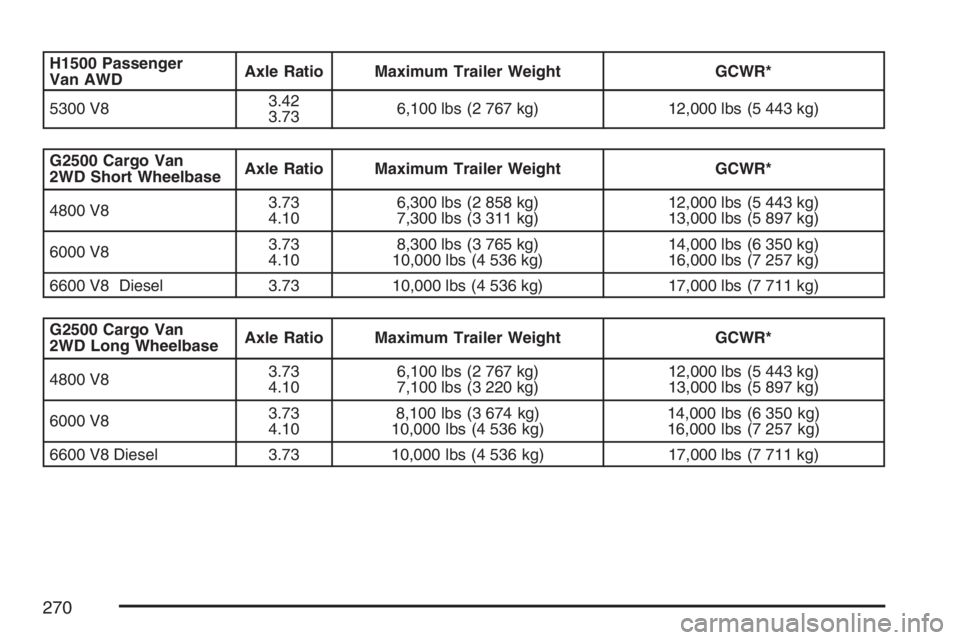
H1500 Passenger
Van AWDAxle Ratio Maximum Trailer Weight GCWR*
5300 V83.42
3.736,100 lbs (2 767 kg) 12,000 lbs (5 443 kg)
G2500 Cargo Van
2WD Short WheelbaseAxle Ratio Maximum Trailer Weight GCWR*
4800 V83.73
4.106,300 lbs (2 858 kg)
7,300 lbs (3 311 kg)12,000 lbs (5 443 kg)
13,000 lbs (5 897 kg)
6000 V83.73
4.108,300 lbs (3 765 kg)
10,000 lbs (4 536 kg)14,000 lbs (6 350 kg)
16,000 lbs (7 257 kg)
6600 V8 Diesel 3.73 10,000 lbs (4 536 kg) 17,000 lbs (7 711 kg)
G2500 Cargo Van
2WD Long WheelbaseAxle Ratio Maximum Trailer Weight GCWR*
4800 V83.73
4.106,100 lbs (2 767 kg)
7,100 lbs (3 220 kg)12,000 lbs (5 443 kg)
13,000 lbs (5 897 kg)
6000 V83.73
4.108,100 lbs (3 674 kg)
10,000 lbs (4 536 kg)14,000 lbs (6 350 kg)
16,000 lbs (7 257 kg)
6600 V8 Diesel 3.73 10,000 lbs (4 536 kg) 17,000 lbs (7 711 kg)
270